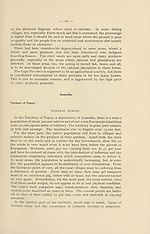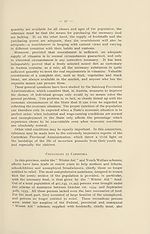Download files
Complete book:
Individual page:
Thumbnail gallery: Grid view | List view

20
Mandated Territory of New Guinea.
Nutrition of the Indigenous Population.
Village natives live under conditions which have varied extremely
slightly from those existing prior to European invasion, which, in some
areas, has existed for forty or fifty years, in others only a few years,
and in others where the influence of European culture has been only
sufficient to curb tribal warfare.
Nutritional problems of the non-indentured portion of the population
must, therefore, be considered under subheadings, which are mainly
environmental. Before subdividing the study of diet from the point
of view of environment, it must be understood that the native population
is largely vegetarian—the staple diet is mainly carbohydrate, whether
it is kau-kau (sweet-potato), taro, sac-sac (sago), tapioc (tapioca) or
pit-pit. Later introduction of coconuts in coastal areas has considerably
improved the dietetic balance.
All protein and fatty foods (other than the small amounts of these
contained in the local carbohydrate diet) are considered luxuries, and
are added to the staple diet when available, whether they consist of
fish in the coastal regions, pigs in all regions, kapuls (squirrels), flying
foxes and muruks (cassowaries) in the interior, and coconuts and galip
nuts in areas in which they grow.
Many green vegetables are eaten in all parts of the territory, but
the variety is so diverse in different areas that tabulation is difficult,
each section of tribes having its own list of bush plants and leaves which
are recognised as a necessity for addition to the local diet.
In spite of the apparent shortage of proteins and fats, the average
diet in villages is sufficient for the physical well-being of its inhabitants.
Famines are almost unknown, and only occur in mountain areas in
rare times, in which droughts destroy the crops, or in river-beds, where
occasional floods wash away the gardens.
The universal prevalence of malaria, frambcesia and filaria (especially
malaria) has much more influence on the morbidity and (especially
infant) mortality than any shortage of food. The universal occurrence
of tropical ulcers may, as has been stated, be of dietetic origin, but
statistical figures since 1930 show an incidence in village population
of only 2.7%.
Austria.
General Observations.
The Federal Ministry for Social Welfare considers that the nutrition
enquiry initiated by the League of Nations should not be regarded as
concerned with medical or health questions in the narrower sense of
the term, but that the problem under discussion is substantially an
economic one. For, if there is any question of difficulty or impossibility
of obtaining food supplies when foodstuffs of every quality and in ample
Mandated Territory of New Guinea.
Nutrition of the Indigenous Population.
Village natives live under conditions which have varied extremely
slightly from those existing prior to European invasion, which, in some
areas, has existed for forty or fifty years, in others only a few years,
and in others where the influence of European culture has been only
sufficient to curb tribal warfare.
Nutritional problems of the non-indentured portion of the population
must, therefore, be considered under subheadings, which are mainly
environmental. Before subdividing the study of diet from the point
of view of environment, it must be understood that the native population
is largely vegetarian—the staple diet is mainly carbohydrate, whether
it is kau-kau (sweet-potato), taro, sac-sac (sago), tapioc (tapioca) or
pit-pit. Later introduction of coconuts in coastal areas has considerably
improved the dietetic balance.
All protein and fatty foods (other than the small amounts of these
contained in the local carbohydrate diet) are considered luxuries, and
are added to the staple diet when available, whether they consist of
fish in the coastal regions, pigs in all regions, kapuls (squirrels), flying
foxes and muruks (cassowaries) in the interior, and coconuts and galip
nuts in areas in which they grow.
Many green vegetables are eaten in all parts of the territory, but
the variety is so diverse in different areas that tabulation is difficult,
each section of tribes having its own list of bush plants and leaves which
are recognised as a necessity for addition to the local diet.
In spite of the apparent shortage of proteins and fats, the average
diet in villages is sufficient for the physical well-being of its inhabitants.
Famines are almost unknown, and only occur in mountain areas in
rare times, in which droughts destroy the crops, or in river-beds, where
occasional floods wash away the gardens.
The universal prevalence of malaria, frambcesia and filaria (especially
malaria) has much more influence on the morbidity and (especially
infant) mortality than any shortage of food. The universal occurrence
of tropical ulcers may, as has been stated, be of dietetic origin, but
statistical figures since 1930 show an incidence in village population
of only 2.7%.
Austria.
General Observations.
The Federal Ministry for Social Welfare considers that the nutrition
enquiry initiated by the League of Nations should not be regarded as
concerned with medical or health questions in the narrower sense of
the term, but that the problem under discussion is substantially an
economic one. For, if there is any question of difficulty or impossibility
of obtaining food supplies when foodstuffs of every quality and in ample
Set display mode to:
![]() Universal Viewer |
Universal Viewer | ![]() Mirador |
Large image | Transcription
Mirador |
Large image | Transcription
Images and transcriptions on this page, including medium image downloads, may be used under the Creative Commons Attribution 4.0 International Licence unless otherwise stated. ![]()
| League of Nations > Economic and financial section > Problem of nutrition > (22) |
|---|
| Permanent URL | https://digital.nls.uk/190924048 |
|---|
| Shelfmark | LN.II |
|---|
| Description | Over 1,200 documents from the non-political organs of the League of Nations that dealt with health, disarmament, economic and financial matters for the duration of the League (1919-1945). Also online are statistical bulletins, essential facts, and an overview of the League by the first Secretary General, Sir Eric Drummond. These items are part of the Official Publications collection at the National Library of Scotland. |
|---|---|
| Additional NLS resources: |
|

